Genetic engineering campaign
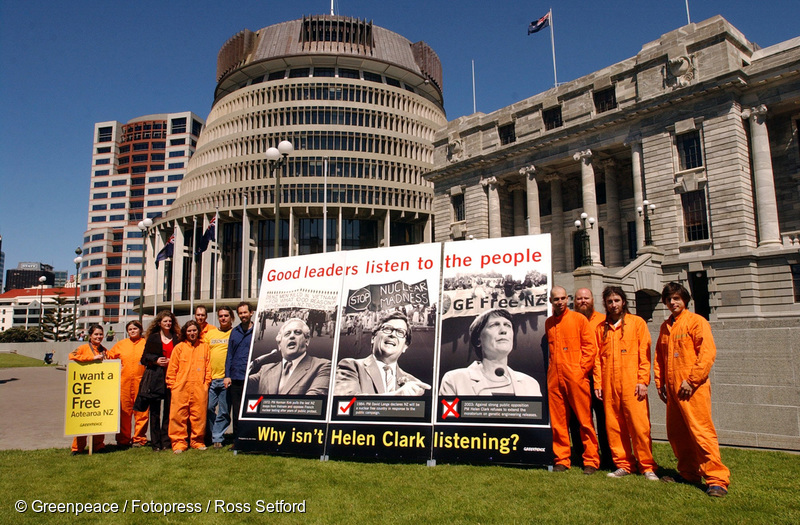
Origins
Greenpeace started working on the genetic engineering (GE) issue in 1992. Initially it was part of the work undertaken by Pesticides Campaigner Meriel Watts. That year, Greenpeace applied for a review of two GE field trial applications near Gisborne. As a result of Greenpeace’s intervention, the two field trial applications were not approved, and the case highlighted the fact that NZ had no legislation protecting the environment and human health from the commercial importation and exploitation of GE organisms.
Meriel Watts made further submissions to proposed new legislation in 1993 which urged that GE technology not be allowed into NZ and instead promoted organic and ecological agriculture as positive alternatives.
GE field trials
The GE work moved up a gear in 1996 when Greenpeace launched a campaign targeting new GE field trial proposals. The first target was an action with local residents protesting against a GE field trial near Oamaru.
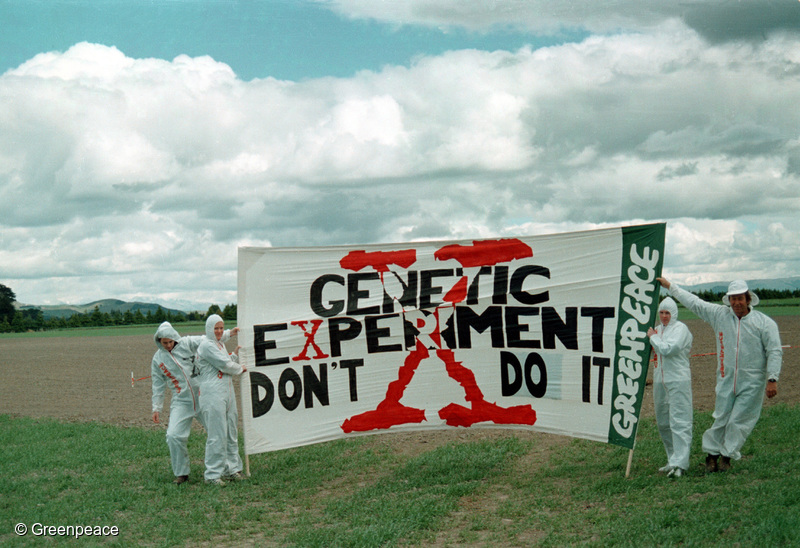
At the time, the potential risks posed by GE technology was an emerging issue of public concern, so the campaign also aimed to educate supporters and the public by publishing articles about it in its members’ magazine and encouraged members to make submissions to proposed food standards on the use of GE ingredients in foods, various proposals for GE releases as part of ‘field trials’, and to the Minister for the Environment.
The call for a moratorium
In December 1996 Greenpeace urged the NZ Government to put in place a moratorium on the release of GE organisms into the environment and use of GE ingredients in foods.
This was followed in 1997 with the establishment of a consumer network that Greenpeace called ‘Genetic Detectives’ to write to supermarkets urging them not to sell GE foods, and to help Greenpeace compile a list of companies that were committed to being GE-Free. The information gathered was published by Greenpeace in its GE-Free Supermarkets Action Kit in 1999, a forerunner of Greenpeace’s popular True Food Guide and GE-Free Food Guide that were published in several editions between 2000 and 2008.
By 1999 stopping GE releases into the environment and GE ingredients being used in food products had become high profile issues, and over the next five years the GE campaign became one of Greenpeace’s main campaigns in New Zealand.
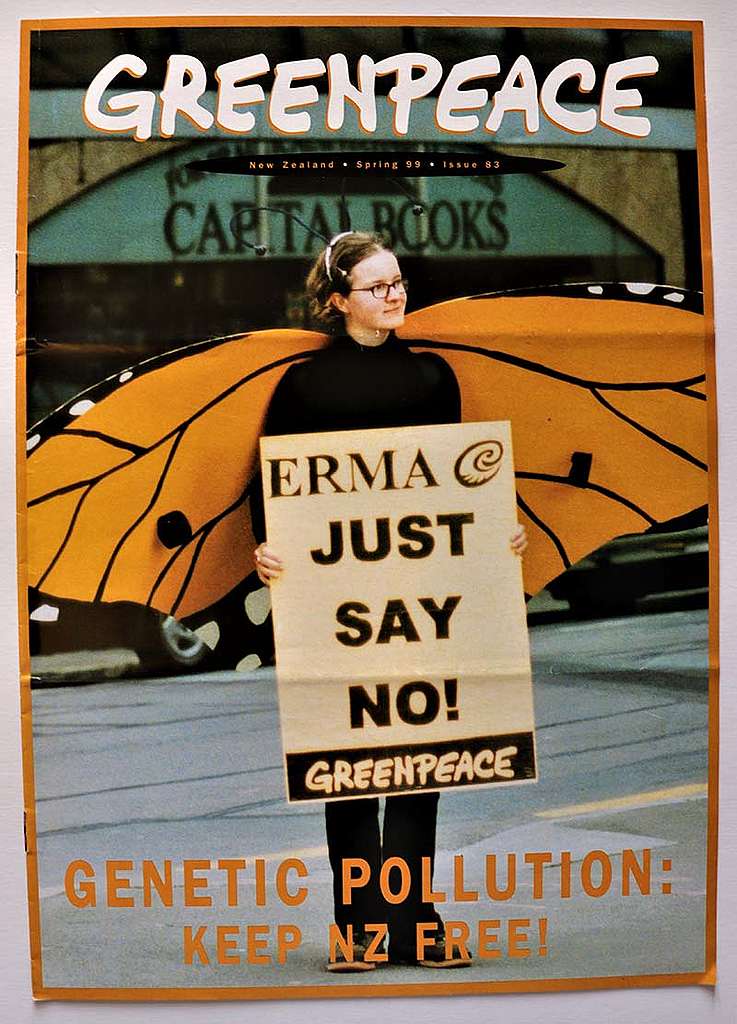
Public opposition to GE grows
An estimated 15,000 people joined GE-Free Day of Action events in 20 cities and towns around New Zealand on 6 October 2000, organised by a coalition of GE-Free groups including Greenpeace.
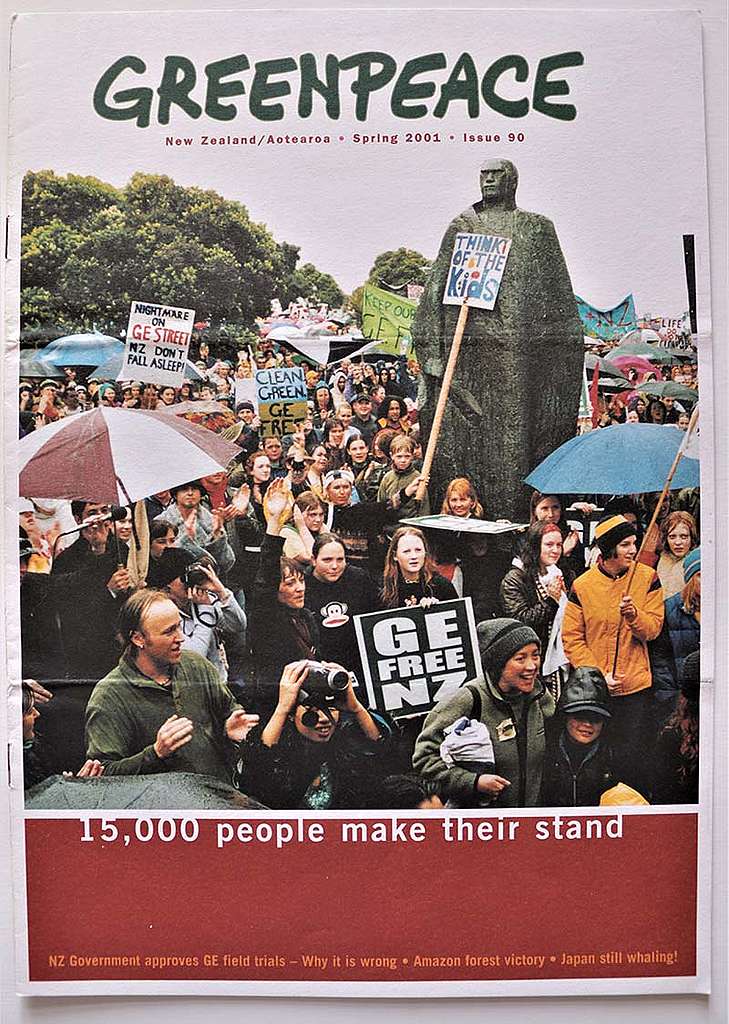
Greenpeace actions also targeted Tegel over its use of GE soya chicken feed and Nestle over its stance on GE ingredients in foods, prior to the NZ Government announcing a voluntary GE moratorium and a Royal Commission on Genetic Engineering in 2000.
Greenpeace’s flagship SV Rainbow Warrior II was welcomed to Tamaki Makarau by Ngati Whatua Trust Board Deputy Chairman Grant Pakihana Hawke in December 2000 at the start of its two-month nationwide tour campaigning for a GE-Free Future.
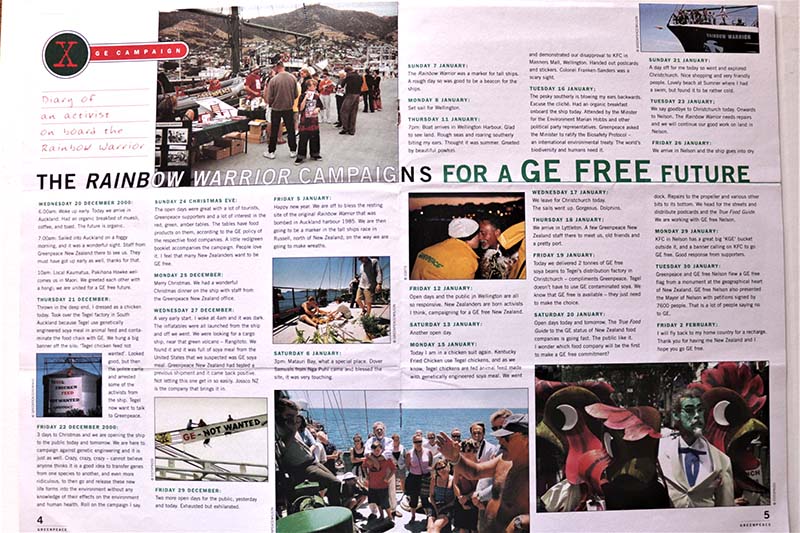
True Food Guide
In May 2001 Greenpeace launched an updated True Food Guide which showed that most NZ food companies were going GE-free. Later in the year, the NZ Government announced it would extend the existing voluntary GE moratorium and shortly after that Tegel announced it would go GE-Free.
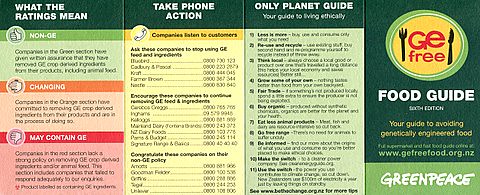
Major brands go GE-Free
The campaign targeting supermarkets and food companies started to bear fruit. The next GE campaign victory came when Progressive Enterprises Ltd announced it would adopt a GE-free policy for its own brand products in November 2001. The company covered about a quarter of the NZ retail grocery market and operated the Foodtown, Countdown, and 3Guys supermarket banner groups, and was the franchise co-ordinator for the FreshChoice and SuperValue banner groups.
In 2002 Greenpeace produced a new edition of its GE-Free Food Guide. More than 80,000 copies were distributed and public meetings on GE technology organised around the country.
An estimated 15,000 people joined a GE-Free Rally in Auckland City on 16 November 2002. Beginning at Aotea Square, the marchers filled Queen Street for over an hour before marching up Queen Street for a GE-Free New Zealand.
“For the second time in a year, thousands of people marched in the rain to say they want New Zealand’s agriculture and environment to stay GE-Free,” said Greenpeace GE Campaigner Steve Abel. “This is a clear message to the Government and the biotech industry from the people of New Zealand – Prime Minister Helen Clark must take notice.”
Greenpeace New Zealand, Mothers Against Genetic Engineering (MAdGE), GE-Free NZ, Green Gloves, and other members of the Auckland GE-Free Coalition took part in the rally.
The colourful parade of banners, placards and costumes ended in Albert Park where people were entertained by Trinity Roots, the Topp Twins, and Golden Horse, and listened to speeches by Waitakere Mayor Bob Harvey, MAdGE’s Allanah Currie, MC Slave, and others.

On 11 October 2003 an estimated 35,000 people marched up Queen Street in Auckland calling for an extension of the GE moratorium. The massive turn-out made it one of New Zealand’s biggest marches, which was supported by Greenpeace, Mothers Against Genetic Engineering (MAdGE), and the Auckland GE-Free Coalition.
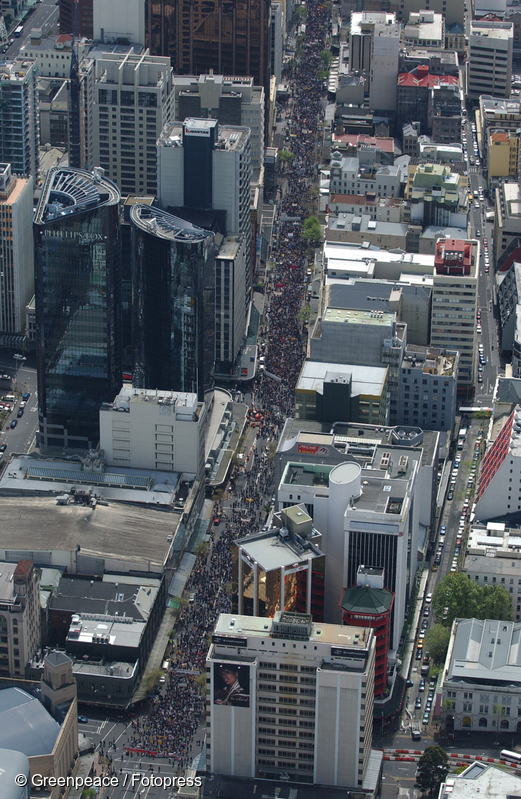
“Today made history much the same as the nuclear-free protests in the 1980s,” said Greenpeace GE Campaigner Steve Abel. “We have a nuclear-free New Zealand because the government listened to the people and the government must listen to this huge expression of public feeling and extend the [GE] moratorium.”
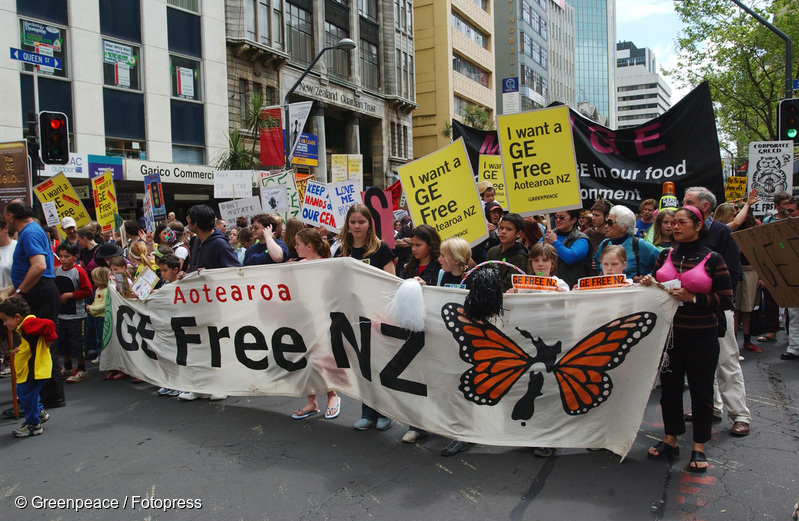
Large majority opposes GE releases and GE foods
Opinion polls repeatedly recorded a large majority of the NZ public during the period 2000–2004 opposed to GE releases into the environment, and GE ingredients in foods. Despite this, Helen Clark’s Labour-led Coalition Government ended the voluntary GE Moratorium on 27 October 2003.
Greenpeace and the other groups campaigning against GE releases in New Zealand responded with a strong message that ‘the battle is not over’ and launched ‘The People’s Moratorium’.
Greenpeace’s GE Campaign, now led by campaigner Steve Abel, urged the public to demand that food companies continue to remove GE ingredients from their products and to challenge all new applications to grow GE crops in New Zealand.
The continued pressure paid off. In November 2003 Foodstuffs (Pams and Budget brands) adopted a GE-free policy, and Goodman Fielder joined Australasian food companies Heinz Watties and Unilever in going GE-Free.
Before Greenpeace, Steve Abel got involved in the successful Native Forest Action (NFA) campaign against rainforest logging on the West Coast by Timberlands in the late 1990s. After that he was one of a new influx of young activists that came to work for Greenpeace during the early 2000s who had all worked on the NFA campaign, including Annette Cotter, Chris Hay, Logan Petley, Dean Baigent-Mercer, and Nick Young.
Ronald McDonald quits over GE chickens
Following the GE campaign’s success in persuading supermarkets and big food companies to adopt GE-free policies, Greenpeace also started targeting GE soya fed chickens produced by Tegel and Inghams, and used by fast food giants KFC and McDonalds.
In January 2001 Greenpeace activists delivered two tonnes of GE-free soya to a Tegel factory in Christchurch, urging the company to commit to using only GE-free soya chicken fee.
In September 2003, chicken-suited Greenpeace activists closed down the Inghams/Harvey Farms soya chicken feed factory in Hamilton by blocking the entrance and hanging a giant banner that read, “Onghams – GE Feed Not Wanted”. They demanded that the company instead switch to using only GE-free soya chicken feed.
Greenpeace used SV Rainbow Warrior II to blockade an Inghams shipment of GE soya chicken feed in early 2004 shortly before embarking on a GE-Free tour of New Zealand.
Shortly after the tour, in one of its most memorable actions devised by Steve Abel, Greenpeace organised for ‘Ronald McDonald’ to hand in his resignation at the Queen Street branch of McDonalds over the GE soya fed chicken issue. In this case, ‘Ronald’ was played by a friend who was also an actor.
Then in May 2004, Greenpeace activist Gareth Hughes – in full ‘Ronald McDonald’ regalia – was arrested for chaining himself to the gates of McDonalds’ distribution centre in Wiri, Auckland, in protest at the company’s use of GE soya fed chickens.
‘Ronald’ was led to a police car wearing a mocked-up chain and was driven away to be charged with disorderly conduct at the local police station. A photograph of a glum-faced ‘Ronald’ staring out of the window of the police car appeared around the world and it became one of Greenpeace’s most iconic protest actions. Once again, as Gareth Hughes recalls, “Steve Abel was the genius behind it.”
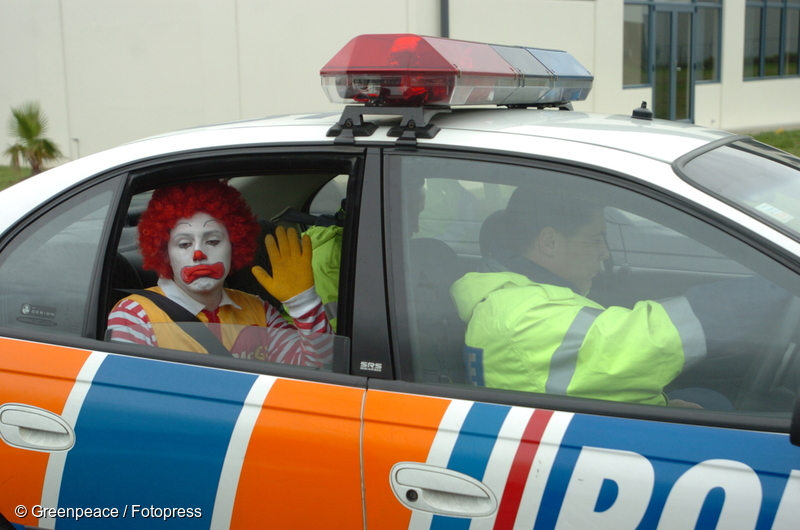
“While the campaign has been humorous and good natured the issue itself is a serious environmental one,” said Greenpeace GE Campaigner Steve Abel. “GE crops have led to an increase in herbicide use, lower yields, weed problems, and contamination of conventional and organic crops.”
McDonald’s goes GE-Free
Two weeks later McDonalds New Zealand announced that it was seeking a non-GE feed supply for its chicken products and would shift over as soon as it could to GE-free chicken feed. Greenpeace’s ‘Ronald McDonald’ campaign had worked.
In retrospect, Greenpeace’s campaign against GE technology and GE foods was successful in pushing the NZ Government to establish and extend the GE moratorium for three-and-a-half years from April 2000 to October 2003 while the Royal Commission on GE technology ran its course and reported back to the Government.
The campaign also succeeded in helping to create a mass public mobilisation in opposition to GE technology and GE foods.
Using a combination of consumer-led pressure and well-timed creative direct actions targeting big brands such as McDonalds that caught the public imagination, it was highly effective in persuading companies and retailers to adopt GE-Free policies and to sell only GE-Free foods.
Steve Abel continued to lead the GE Campaign until 2005, when he became Greenpeace’s Climate Campaigner. After several more years with Greenpeace, Gareth Hughes went on to stand for Parliament and became a Green Party MP (2010-2020).
NZ Government ignores GE-Free public opinion
Ultimately, however, all of this was ignored by the Labour-led Coalition Government in 2003 when it refused to convert the moratorium into a ban on GE releases into the environment and a ban on GE ingredients in foods.
Greenpeace won the campaign in the court of public opinion and achieved important victories by helping to harness consumer buying power, but the government of the day ignored that and chose to put GE technology ahead of the public interest.
The inside story of why Helen Clark’s Labour-led Coalition Government chose to do that is yet to be told publicly. They appear to have tried to ‘park the issue’ to buy time with a long drawn-out Royal Commission process during the GE moratorium, perhaps in the hope that public opposition to GE technology and GE foods would subside, but if that was the strategy it emphatically did not work.
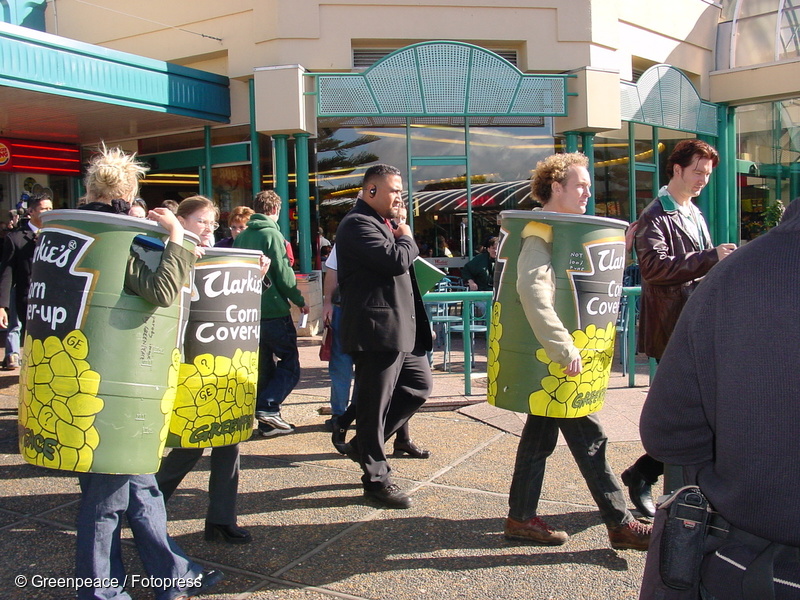
Greenpeace’s GE Campaign, Toxics Campaign, and Climate Campaign all shone a spotlight on different aspects of the environmental impacts of NZ agriculture in the 1990s.
In the 2000s, the environmental impacts of NZ agriculture became an increasingly important issue for Greenpeace, resulting in Gordon Jackman writing a report on ecological agriculture in 2006 to help guide Greenpeace’s future campaign work. That work continues today through Greenpeace’s Agriculture Campaign.
